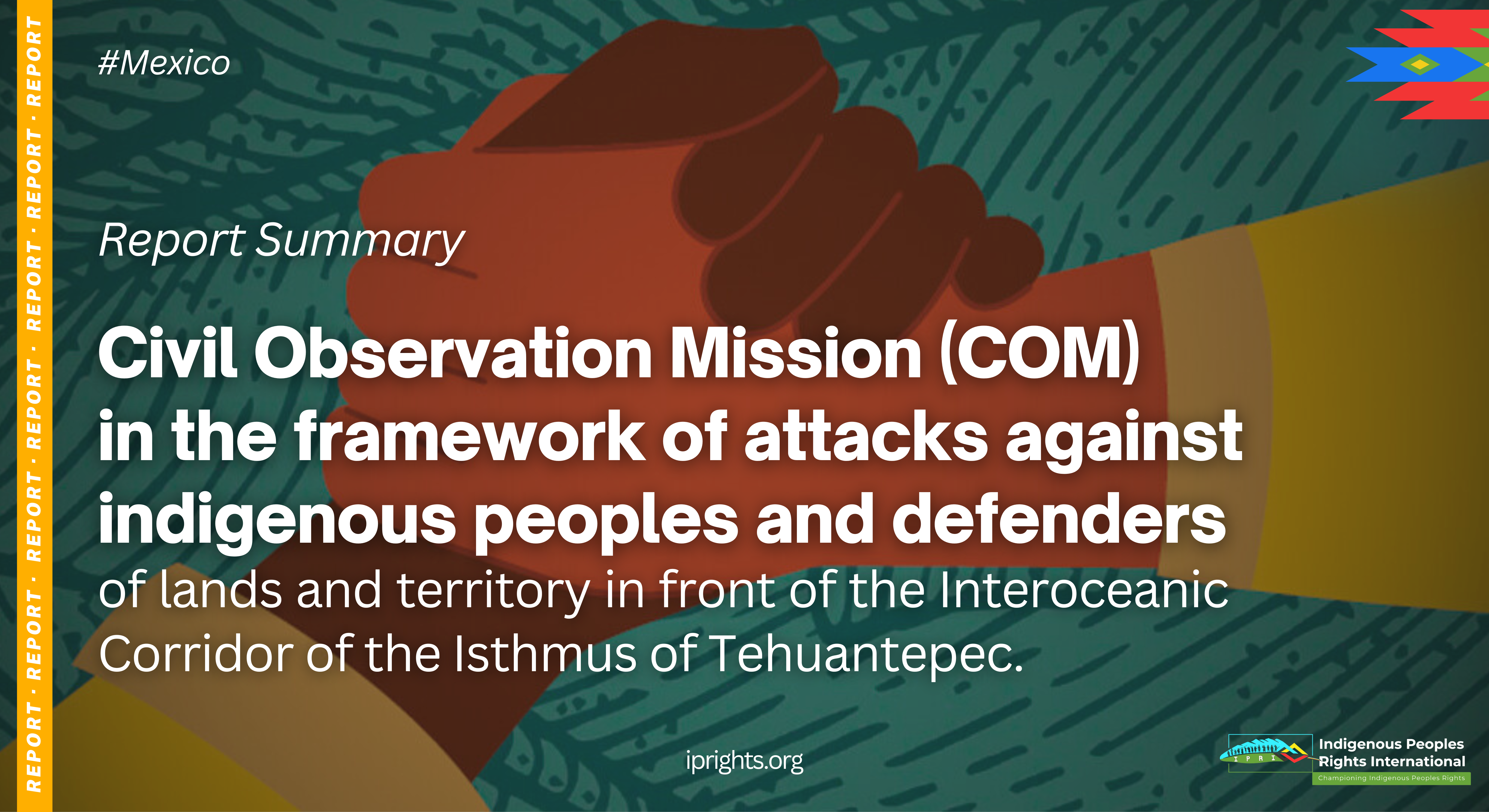Civil Observation Mission (COM) in the framework of attacks against indigenous peoples and defenders of lands and territory in front of the Interoceanic Corridor of the Isthmus of Tehuantepec.
Report Summary
Context
A. Large-scale project of the Interoceanic Corridor of the Isthmus of Tehuantepec
In the southeast of Mexico there is a 200 km wide area located in the states of Oaxaca and Veracruz. It is the narrowest land area connecting the Pacific and Atlantic Oceans. A large number of Indigenous Peoples live in this territory, considered a biodiversity highspot. A huge economic project called the Interoceanic Corridor of the Isthmus of Tehuantepec ('CIIT') is being developed in this region.
The CIIT “development” project was launched in December 2018, as part of the Tehuantepec Isthmus Development Plan – also known as the Tehuantepec Isthmus Development Program.[1]. The main objective of this Plan is to have a more efficient connection between the ports of Coatzacoalcos, in Veracruz, and Salina Cruz, in Oaxaca This through the modernization of different kinds of infrastructures, mainly rail transport. At the same time, it aims to strengthen energy infrastructures, both oil refining and gas supply, the establishment of industrial parks, modernization and creation of road infrastructures, an airport network and the creation of development poles [2].
Initially, the project will be developed in around 76 municipalities in Oaxaca and Veracruz, where communities of several Indigenous Peoples are located, such as the Binnizá or Zapoteca, Ayuuk or Mixe, Zoque, Ikoots or Huave, Chontal, Chinantec, Mazatec, Mixteco, Popoluca and Nahualt peoples. There is also Afro-Mexican population in the area [3].
Ongoing and potential impacts range from the environmental to the social. According to reports developed by experts in various disciplines and the experiences shared by the communities, the CIIT in its authorization and development processes has involved, at least [4]:
Although there are no official reports on the current status of the various components that make up the CIIT project, indigenous peoples and communities in the region have stressed the following impacts: [5]:
● Impacts to their territories. There are environmental impacts on their communities due to the construction of the electrical grid, gas pipelines, industrial parks and roads. Building companies generate waste that is left on their lands, and the construction of the different components of the project results in felling of trees and damage to endemic flora and fauna[6].
● Militarization. The presence of the National Guard (GN), Secretariat of the Navy and the Secretariat of National Defense (SEDENA), as well as the increase in the presence of the state police and Civil Force - in Veracruz - in the communities where the CIIT is being developed [7].
● Lack of information about the project. Residents of the communities visited during the CFM expressed their ignorance on the scope of the project. Through various testimonies, they indicated that they were not informed about the elements related to the CIIT, its impacts or environmental, social or economic consequences. They have only learned about the project when work starts within their lands and territories. [8]
● Omissions in the protection of their rights to self-determination, autonomy, free, prior and informed consent and free, prior, informed, good-faith and culturally appropriate consultation. The communities affected by the CIIT project state that they have not had the necessary or sufficient guarantees for the exercise and protection of their rights as indigenous peoples. In addition, they have been denied recognition as subjects of public law by the nonrecognition of the community assemblies as legitimate decision-making bodies. The CIIT is being carried out without the consent of the affected peoples and their communities [9].
Thus, despite the lack of adequate mechanisms for the effective protection and guarantee of the right to self-determination and free prior informed consent, and the absence of free, prior, , informed, good-faith and culturally appropriate consultations with the Indigenous Peoples impacted by the project, the imposed project continues developing .
[1]Official Gazette of the Federation, Program for the Development of the Isthmus of Tehuantepec 2020-2024, August 4, 2020, available at: https://www.dof.gob.mx/nota_detalle.php?codigo=5597712&fecha=04/08 /2020#gsc.tab=0
[2]Government of Mexico, Logistics Platform of the Interoceanic Corridor of the Isthmus of Tehuantepec, December 1, 2023, available at: https://www.gob.mx/ciit/articulos/folleto-corredor-interoceanico-del-istmo-de-tehuantepec ?idiom=es
[3]National Development Plan (PND), 2019-2024 published in the Official Gazette of the Federation on July 12, 2019.
[4]Ceceña, Ana Esther (Coord.), The Isthmus of Tehuantepec at risk, Latin American Geopolitics Observatory, UNAM, February 2012, available at: https://geopolitica.iiec.unam.mx/sites/geopolitica.iiec.unam. mx/files/2021-04/Istmo%20de%20Tehuantepec%20en%20risk_0.pdf
[5]San Juan Guichicovi, Hierba Santa, Boca del Monte, Mogoñe Viejo, Rincón Viejo, just to name a few.
[6]Footer, 200 trees will be torn down to build work on the Interoceanic Corridor, July 23, 2023, available at: https://piedepagina.mx/derribaran-200-arboles-para-construir-obra-de-corredor-interoceanico/
[7] See PODER Latam, Militares SA de CV, Otra via al Militar-Istmo, February 27, 2024, available at: https://poderlatam.org/wp-content/uploads/2024/02/Militares_SAdeCV.pdf
[8]Testimonies received at the “Tierra y Libertad” Camp, in Mogoñe Viejo, Oaxaca. And Des-Informémonos, Ecocide and lack of transparency in CIIT works, denounce Zapotec defenders, May 9, 2023, available at: https://desinformemonos.org/ecocidio-y-falta-de-transparencia-en-obras- del-ciit-denuncian-defensores-zapotecs/
[9]Aristegui Noticias, Judge suspends construction of industrial park in Corredor del Istmo, June 14, 2023, available at: https://www.aristeguinoticias.com/1406/mexico/juez-suspende-construccion-de-parque-industrial-en -isthmus-corridor/


%2020.49.20.png)
